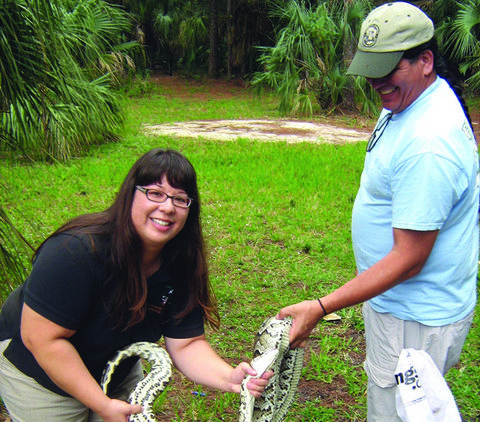
1 -888-I’VE-GOT-1 (1- 888-483-4681) is the telephone number Florida Fish and Wildlife Conservation wants South Floridians to call if spotting a Burmese python. Your call may help research, if not outright capture one of an estimated 30,000 to 300,000 of the slithery constrictors thought to be roaming the state’s sub-tropical areas. For online reporting go to IveGot1.org.
The average size of Burmese pythons on the loose in backyards and boondocks is eight to 10 feet, although a single sighting has reached 18 feet, six inches.
“They’re hard to see, and both hard and dangerous to capture,” warned Jenny Novak, coordinator of the state agency’s “Python Patrol” at A. D. “Doug” Barnes Park EcoVenture Center, while conducting a training session on Jan. 24, to help residents identify exotic species that are overrunning the local landscape.
A second free workshop is scheduled 10 a.m.-noon, on Sunday, Feb. 22, at Bill Sadowski Park, 17555 SW 79 Ave. in Palmetto Bay, directed by Novak and her assistant Jeff Fobb. For online registration visit www.MyFWC.com/Python.
“We’re trying to get South Floridians to become aware of the difference between exotics and native species,” Novak said. “We get reports all the time of native Florida snake and lizard kills because people can’t distinguish exotics from harmless native species, including those that may be on an endangered list.”
It is why Novak enlisted the aid of two Miami-Dade parks to detail the dangers as well as the knowledge needed for amateur snake-hunters before they make instant decisions on killing native reptiles, including corn snakes and water snakes that help preserve nature’s balance of wildlife.
“You shouldn’t march out into the woodlands to hunt and kill pythons,” noted Novak who said requirements begin with a state hunting license and a special permit to go into protected areas like the South Florida’s Water Districts.
Unlicensed killing of protected species can result in a $1,000 federal fine and up to a year in prison.
Florida’s Wildlife Commission has narrowed the list of outlaw constrictor snakes to eight — most of which “seem to just melt into our environment,” Novak said. She cautioned, “Stay 15 feet away from a python discovery until you can accurately determine what you are seeing.”
Telephoned reports by iPhones with pictures of pythons on the loose are encouraged because the device embeds GPS-location data for research and response.
As an initial step in recognition training, she advised taking the University of Florida’s free online “Reptile Early Detection and Documentation” (REDDY) as a first step, available at http://ufwildlife.ifas.ufl.edu.reddy.stml.
“Call ‘I’VE-GOT-1’ as quickly as possible if you have a sighting,” Novak urged, noting Miami-Dade County also will attempt capture if reports are timely enough to locate a wayward reptile out of sync with a South Florida habitat.






